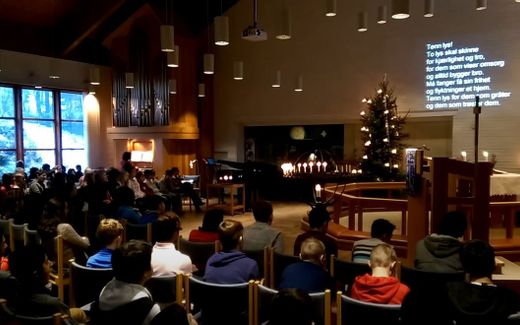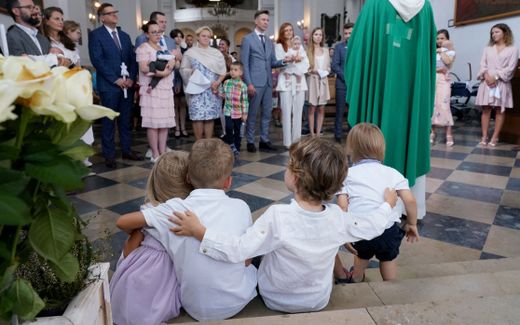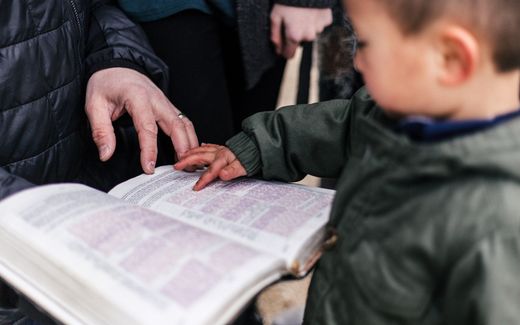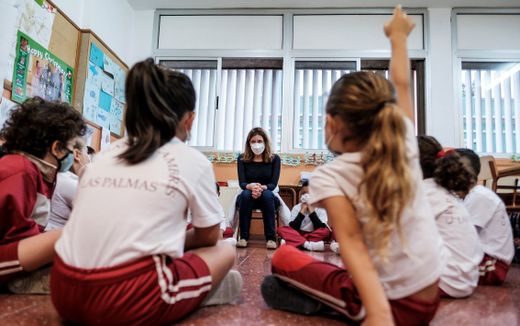From a Bible story to a way of salvation
10-05-2023
Christian Life
Linda den Hollander, RD
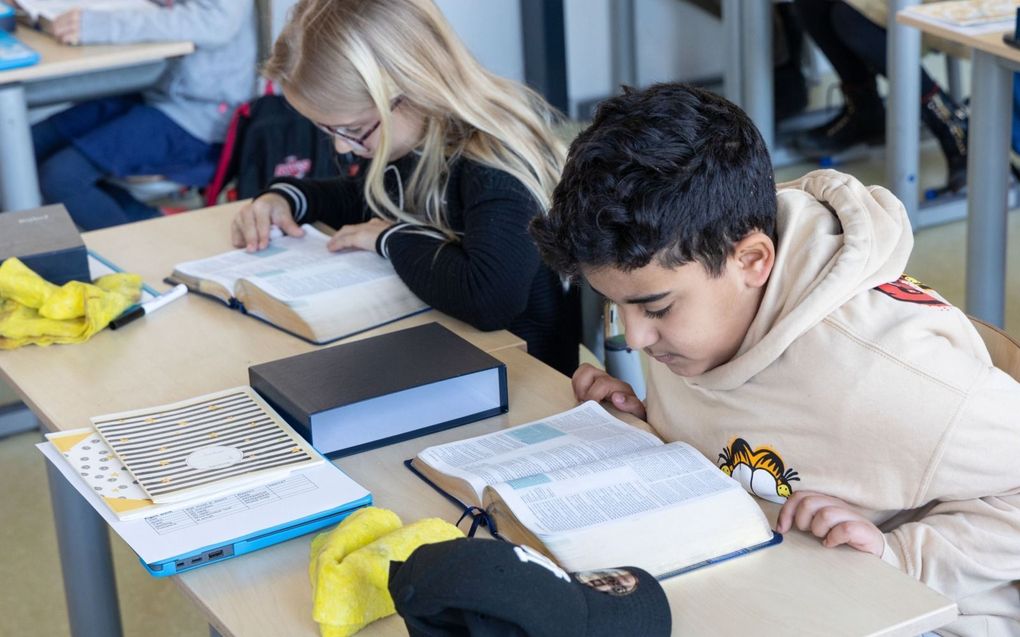
Students at the Dutch primary school reading from their Bible. Photo RD, Anton Dommerholt
Christian Life
The Bible is a book full of stories. About Adam and Abraham, David and Daniel, Rahab and Ruth. And above all: about Jesus Christ, the Son of God. How can teachers point children to that common thread of salvation in Christ which connects all these histories?
"Who wants to hand out the Bibles today?" asks teacher Cornel Stout. It is Wednesday morning, quarter to nine. Grade 5 (pupils aged 10 to 11) of the Christian Reformed Eben-Haëzer school in the Dutch city of The Hague is ready for the day's opening. Three pupils walk to the bookshelves at the back of the classroom with over twenty dark blue copies of the Bible, tidily back-to-back, with a sticker on each edition bearing the name of a pupil.
"Those who have their Bibles can look up Matthew 6 verses 19 to 34," says Stout. Frantic browsing follows. Not every child can find the Bible section immediately, so the teacher lends a hand. "Page 1460." That saves searching. "Which word is written as a summary above the text?" asks Stout once each child has the chapter from Matthew's Gospel in front of them. Luke knows. "Concern." "But what does that mean," the teacher asks. "In pairs, think about an example for a moment."

His question loosens tongues. Several students mention their mothers. Ivo: "When I go for a walk in the woods by myself at night, my mother is concerned. She doesn't want me to do that." So concern has a lot to do with anxiety, Stout concludes, after which he asks pupil Lois if she would like to read verse 19.
"Do not lay up for yourselves treasures on earth, where moth and rust[e] destroy and where thieves break in and steal," echoes through the classroom. Moth and rust, laying up and breaking in and stealing: those are a lot of difficult words, Stout observes. And so, one by one, the teacher runs through the meanings of the tricky terms with the students.
Scrooge McDuck
"Why would anyone want to collect a lot of stuff anyway?" he asks. Because he keeps thinking he doesn't have enough, Lucas suspects. Again Stout asks for an example. "Scrooge McDuck," says one of the students. Hilarity abounds. But it is a good answer. "Because actually, Dagobert Duck is always scared. He doesn't want to lose his money. After all, if he loses it, he has nothing left."
Giovanni, Jesse, Mirthe, Ralph: taking turns, Stout has one of the pupils read a verse aloud. Each time, he explains the difficult words, makes the children think of examples and asks what the text means for everyday life. "Being afraid belongs to those who do not serve God. But if you do serve Him, you are happy. Then you have a heavenly Father; He takes care of you every day."
Events
For a teacher in a Christian school, it is a daily recurring moment: the Bible lesson at the beginning of the morning. Especially in primary classes, teachers usually do this by telling about a history from the Bible - the so-called Bible story. Stout: "This is how the teacher brings events from God's Word close to home."
At the same time, that form, in which a different part of the Bible takes stage daily, comes with a risk. Namely, that children gain insight into the individual histories in God's Word but not its overarching message. As a result, children have a poor understanding of how the different stories fit into the red thread running through the Bible.
"If you really want to understand a book, you shouldn't just read some individual pages over and over again," says Peter van Olst, lecturer in religion and researcher at Driestar University of Applied Sciences in Gouda. "Only when you know what the main theme is can you understand the various details." The same applies to telling the Bible story, he stresses. "Only when teachers know the Bible's main message, the common thread, and how the individual histories fit with it can they shape the Bible lesson in a balanced way."
Core message
But what, then, is that central message? What forms the common thread between all the individual books of the Bible? "Every child needs a Saviour," Stout says. "And the hopeful thing is that this Saviour has also come. That is the core message to which God's Word points." Van Olst: "The red line in the Bible is God's revelation. God reveals His Son to sinful people for the purpose of reconciling them to Himself."
The New Testament introduces Christ, says the former missionary. "The Old Testament already announces His coming. This happens in the Psalms, the miracles and the sacrificial service, among others. Everything points towards Jesus' coming."
Teachers should hold onto that in their telling of Old Testament histories, says Van Olst. "After all, if they don't, you end up with moralising stories that throw students back on themselves."
Repentence
Using Numbers 20, the teacher explains what he means by this. That chapter describes the Israelites running out of water. After the people complain about this to Moses, Moses goes to the Tabernacle. God tells Moses to speak to the rock, then water will come out. Moses does not do so but strikes it with his staff. Water comes out, but God also tells Moses and Aaron not to enter the land of Israel.
With such a story -without keeping the big picture of God's revelation in mind- several applications can be made, Van Olst explains. "A teacher can then say to the pupils: Moses and Aaron did not do what the Lord asked of them, and therefore, they were not allowed to enter the promised land. The message then is that it is important to do what the Lord asks." In addition, he says, a teacher can point out that by nature, no one listens to what God says. "The lesson for the children then is: repentance is necessary," he says.
Revelation
Both things are true in themselves, observes the Gouda teacher. Yet a narrative about that history, he says, must go deeper. "If the revelation of God is the common thread in His Word, then a teacher must ask himself the question: What does this story say about God, Who does not let go of the world and reveals His salvation?"
Looking at the same history in such a way gives the story about it a different, deeper focus and a message of hope. Van Olst: "Then it is not primarily about the people of Israel doing things right or wrong, but a teacher shows the pupils that nothing can be expected of people themselves. And that God repeatedly takes the people by the hand and sustains the Israelites. The direction of gaze thus shifts from man to God."
In addition, the Trinity lecturer points out that 1 Corinthians 10 speaks of Christ as the spiritual Rock. "Such a text provides a good starting point to put Him at the centre of this history. Why would Paul make that comparison? These are questions that are excellent to address with students. That way, in such an Old Testament history, a teacher focuses the students on Christ."
Fragmentary Bible teaching
Once teachers lose sight of the common thread of salvation in Christ, only fragmentary Bible teaching remains, says Van Olst. "Then each story has a separate message, and it is also often not so clear what a history of the past has to do with life today."
Recently, the lecturer at the Driestar College spoke to two students. Both had told their primary school class about the story of Elisha and his servant being surrounded by Syrians at Dothan. Both struggled with the meaning of the story for students now. One had emphasised the power of prayer. The other had emphasised how God wants to protect His children. Both, however, were left with questions. Van Olst: "After all, seeing the angels is a miraculous element, and children wonder what that would be like now."
The applications they made are both justified, the Driestar teacher believes. But according to him, the whole thing becomes more apparent when the teacher sees that Elisha is a type of Christ. "It was precisely around the prophets Elijah and Elisha that the Lord performed many miracles and signs, pointing towards the great Prophet Who was to come," he explains. "Angels were present at the great works of salvation He did. Thus, a teacher can simultaneously tell how the Lord, also through prayer, is very close to everyone who fears Him. He protects them and hears their prayers. He sends His angels, even if we do not see them. That they did become visible with Elisha and his boy and with the Lord Jesus has special significance, even though the Lord would certainly be able to do so even now."
Correct and balanced picture
Although the Bible story is the most common way of opening the day in primary schools, other forms are also suitable for this purpose, say Van Olst and Stout. One example is reading from the Bible together, as group 7 of the Eben-Haëzer school in the court city did on Wednesday morning.
"Not every section of the Bible lends itself to a story," Stout explains. "Matthew 6, the section from the Sermon on the Mount on concern, is an example." However, it is essential to cover those sections with students as well, the teacher believes. "After all, if that is not done, you get a thin Bible, and you may wonder whether you are giving pupils a correct and balanced picture of God's Word."
In addition, he believes it is essential that pupils not only listen passively to what a teacher says but also engage with the content of the Bible themselves, for example, by reading a verse aloud, discussing its meaning in pairs or thinking of contemporary examples to a section of God's Word. "Again and again, this should include: what does this mean for each pupil personally and how they stand as Christians in this society? In the end, Bible education is not about knowledge, but about being a child of God."
This article was translated by CNE.news and published by the Dutch daily Reformatorisch Dagblad on May 8, 2023
Related Articles


